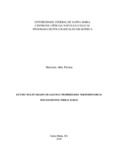| dc.creator | Pereira, Hercules Abie | |
| dc.date.accessioned | 2019-06-05T11:21:29Z | |
| dc.date.available | 2019-06-05T11:21:29Z | |
| dc.date.issued | 2019-02-22 | |
| dc.identifier.uri | http://repositorio.ufsm.br/handle/1/16744 | |
| dc.description.abstract | Lanthanides (La-Lu), Yttrium and Scandium form the group of rare earth elements (REE) are classified as light (LREE) and heavy (HREE). These elements are gaining prominence in surveys due to their economic potential as well as their industrial applications. The REEs have the effect of lanthanide contraction, which keeps their values of ionic radius and ΔfH° close, which causes the REEs to substitute essential ions such as Fe2+, Fe3+ and Ca2+ in plant matrices. A multivariate statistical study was carried out in order to verify if there is a grouping of the REE according to their extensive properties of ΔfH°, ΔfSo, ΔfGo and So. The main components analysis showed the effect of the counterion on ΔfH°, where the OH-, Cl-, PO43- variables showed a decreasing force effect in this thermodynamic parameter in the OH-> PO43-> Cl- order, and indicated that the number of atoms of ligand oxygen induces the value of ΔfH°. The hierarchical cluster analysis performed with the values of ΔfH°, ΔfSo, ΔfGo and So divided the compounds of (REE)FeO3, (REE)PO4, (REE)2O3, (REE)O2, (REE)2O2CO3II, (REE)2Zr2O7 and REE(OH)3 according to their molecular characteristics. Considering the values of ΔfH°, they were divided into three groups H (La, Ce, Pr, Nd and Sm), G (Eu) and F (Gd, Tb, Dy, Tm, Ho, Y, Er, Yb, Lu). The subdivision carried out with values of ΔfH° corroborates with the literature that classifies the REEs in LREE and HREE and assists in the understanding of the greater stability of the REE compounds found in geological matrices. | eng |
| dc.description.sponsorship | Coordenação de Aperfeiçoamento de Pessoal de Nível Superior - CAPES | por |
| dc.language | por | por |
| dc.publisher | Universidade Federal de Santa Maria | por |
| dc.rights | Attribution-NonCommercial-NoDerivatives 4.0 International | * |
| dc.rights.uri | http://creativecommons.org/licenses/by-nc-nd/4.0/ | * |
| dc.subject | Elementos terras raras | por |
| dc.subject | Termodinâmica | por |
| dc.subject | Multivariada | por |
| dc.subject | Analise de componentes principais | por |
| dc.subject | Analise de cluster hierárquico | por |
| dc.subject | Rare earth elements | eng |
| dc.subject | Thermodynamic | eng |
| dc.subject | Multivariate | eng |
| dc.subject | Principal component analysis | eng |
| dc.subject | Hierarchical cluster analysis | eng |
| dc.title | Estudo multivariado de algumas propriedades termodinâmicas dos elementos terras raras | por |
| dc.title.alternative | Multivariate study of some thermodynamic properties of rare earth elements | eng |
| dc.type | Dissertação | por |
| dc.description.resumo | Os Lantanídeos (La-Lu), Ítrio e Escândio formam o grupo dos elementos terras raras (ETR) e são classificados como leves (ETRL) e pesados (ETRP). Estes elementos estão ganhando destaques em pesquisas devido seu potencial econômico, bem como suas aplicações industriais. Os ETR possuem o efeito de contração lantanídica, que mantém próximos seus valores de raio iônico e ΔfH°, o que faz com que os ETR substituam íons essenciais como Fe2+, Fe3+ e Ca2+ em matrizes vegetais. Realizou-se um estudo utilizando estatística multivariada, afim de se verificar, se há um agrupamento dos ETR de acordo com suas propriedades extensivas de ΔfH°, ΔfSo, ΔfGo e So. A análise de componentes principais apresentou o efeito do contra íon no ΔfH°, onde as variáveis OH-, Cl-, PO43- apresentaram efeito de força decrescente neste parâmetro termodinâmico na ordem OH- > PO43-> Cl-, bem como indicou que o número de átomos de oxigênio ligante induz o valor de ΔfH°. A análise de cluster hierárquico realizada com os valores de ΔfH°, ΔfSo, ΔfGo e So, dividiu em grupos os compostos de (ETR)FeO3, (ETR)PO4, (ETR)2O3, (ETR)O2, (ETR)2O2CO3II, (ETR)2Zr2O7 e ETR(OH)3 conforme suas características moleculares. Considerando os valores de ΔfH°, se dividiram em três grupos H (La, Ce, Pr, Nd e Sm), G (Eu) e F (Gd, Tb, Dy, Tm, Ho, Y, Er, Yb, Lu). Esta subdivisão realizada com valores de ΔfH° corrobora com a literatura que classifica os ETR em ETRL e ETRP e auxilia na compreensão da maior estabilidade dos compostos de ETR encontrados em matrizes geológicas. | por |
| dc.contributor.advisor1 | Rosa, Marcelo Barcellos da | |
| dc.contributor.advisor1Lattes | http://lattes.cnpq.br/0308293154958870 | por |
| dc.contributor.referee1 | Cardoso, Carmem Dickow | |
| dc.contributor.referee1Lattes | http://lattes.cnpq.br/3886927196242959 | por |
| dc.contributor.referee2 | Machado, Ênio Leandro | |
| dc.contributor.referee2Lattes | http://lattes.cnpq.br/6922571767923420 | por |
| dc.creator.Lattes | http://lattes.cnpq.br/4895641438195722 | por |
| dc.publisher.country | Brasil | por |
| dc.publisher.department | Química | por |
| dc.publisher.initials | UFSM | por |
| dc.publisher.program | Programa de Pós-Graduação em Química | por |
| dc.subject.cnpq | CNPQ::CIENCIAS EXATAS E DA TERRA::QUIMICA | por |
| dc.publisher.unidade | Centro de Ciências Naturais e Exatas | por |



